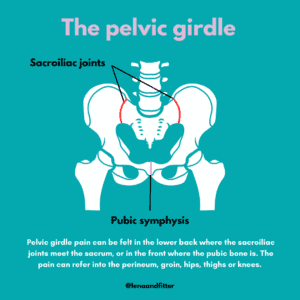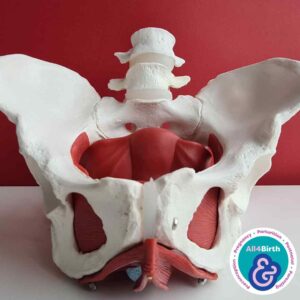Lena Bhohi
Pre and postnatal exercise instructor, personal trainer and mat-based Pilates teacher
@lenaandfitter
Summary
Pregnancy is a beautiful and exciting time in your life, with many changes happening to your body as your baby grows. It is estimated that 1 in 5 people experience pelvic pain at some stage during their pregnancy. This pelvic girdle pain (PGP), previously known as Symphysis Pubis Dysfunction (SPD), is a common condition, with pain usually felt around the pelvic girdle, lower back or front of the hips. Some women may feel a stiffness in their pelvic joints or feel like their joints are moving unevenly.
Pelvic girdle pain can happen at any point in your life, but it’s more common during pregnancy. It can be mild for some and debilitating for others. Understanding the symptoms and tools to manage the condition can help treat it and reduce pain.
What is the pelvic girdle?
The pelvis is designed to support the upper body. Any force or weight from the upper body is transmitted through the pelvic bones, including the sacroiliac joints. The female pelvis is designed for pregnancy, with some joints loosening and opening during childbirth.
The pelvic girdle is a unit of bones joined together by ligaments. It is the home of all your pelvic floor muscles, too. With the added pressure on your pelvis through pregnancy and the softening of these ligaments and tissues due to a hormone called relaxin, there is a little movement in the joints, and sometimes, this can cause inflammation. This movement can contribute to pelvic pain.
The sacroiliac joints (these are located on either side of the spine) and the pubis symphysis joint (at the front of the pelvis) are the joints that move ever so slightly, destabilising the pelvis and leading to pain.

What are the symptoms of PGP?
Pelvic girdle pain is an active pain, usually felt during daily active movements, such as walking, going up and down the stairs and getting in and out of the car. A few people can feel it while lying in bed.
Whilst pain is never normal, it’s worthwhile speaking to your GP when symptoms first arise to look at different measures to treat pelvic girdle pain.
Symptoms of pelvic girdle pain can include:
- A clicking or a grinding feeling in the pelvic joints
- Low back pain
- Pain in the sacroiliac joints at the back of the pelvis
- Pain at the front of the pubic bone
- Groin pain
- Sciatica
The pain may make it more difficult to:
- Walk
- Perform activities on one leg, such as getting changed, getting in and out of the bath and walking up the stairs (this is due to the unstable pressure on the pelvis, which can irritate some of the joints)
- Lie on your back or side
- Open leg positions, such as wide squats and sitting cross-legged
- Rolling over in bed
- Having sex
What can you do to manage PGP?
There are lots of things you can do to try to reduce and manage your pelvic pain. Speak to your GP and ask for a referral to a physiotherapist.
A physiotherapist will carry out a full assessment of your symptoms and provide you with a treatment plan with some exercise information to help reduce your pain.
You could also try:
- Keeping as active as you can and also taking rest breaks when you need to
- Avoid activities where you are on a single leg, such as getting changed. Sitting towards the edge of a bed to get changed can help.
- Try not to sit cross-legged or in any position where your legs are wide apart for too long.
- Be aware of what your body is telling you. If an activity or position aggravates or makes your pain worse, stop and look for an alternative option if possible
- Lying on your side in bed, supported by a pillow under your head and between your knees. This helps to keep your pelvis in a good alignment and can prevent you from rolling over onto your back.
- Try some gentle exercises to strengthen the muscles in and around your pelvic girdle.
Exercises that may help PGP:
Some gentle forms of exercise can help keep you physically active during pregnancy. Walking, swimming, yoga, and Pilates can be beneficial. Ensure the instructor is appropriately trained in pregnancy exercise and aware of your pelvic girdle pain.
Exercises you can try at home to strengthen and support your pelvis and core are:
-
Pelvic floor exercises
- Start by sitting upright on a birth ball or chair or lying comfortably on a mat with your head supported.
- Inhale deeply through your nose to prepare for the exercise
- As you exhale, lift your back passage like you are trying to stop breaking wind. Continue to lift upwards to the front of your pelvis and the front of your pubic bone. Be mindful not to squeeze your buttocks or your jaw. You are purely isolating your pelvic floor here.
- On your next inhale, release your pelvic floor back to neutral.
- Start by trying to hold the lift for 5 seconds for ten repetitions, then gradually increase the hold to 10 seconds as you become stronger.
-
Deep core breathing
This exercise helps to connect your diaphragm, core and pelvic floor.
- Start by lying on a mat with your head supported comfortably.
- Breathe in through your nose and feel your ribs expand to the sides.
- As you exhale through your mouth, lift your pelvic floor from your back passage to the front while breathing out slowly through your mouth until you feel your core contract, fully emptying your lungs. Your ribs will become closer as you exhale.
- On your next inhale, release your pelvic floor and core back to neutral.
- Start by practising this for ten repetitions lying down, and as you feel yourself getting stronger, move to sitting upright or standing.
-
Pelvic tilts
This exercise helps to bring gentle movement into your lower back. It can help reduce stiffness and improve mobility in your lower back.
- Start by lying on your back, on a birth ball/chair or all fours.
- Breathe in through your nose to prepare for the movement.
- As you exhale, gently tilt your pelvis backwards and hold this for 2 seconds. When performing this lying on the floor, it helps to push your back towards the floor.
- On your next inhale, tilt your pelvis back to neutral again.
- Start by practising this for ten repetitions, and when you feel stronger with less pain, increase it to twice a day.
If any of these exercises cause pain, try reducing the intensity or stop and speak with your physiotherapist.
Whilst pelvic girdle pain can be a real pain in the backside, you need not have to suffer. There are treatment options and exercises which can help.
Links to other resources
 Websites
Websites
The Pelvic Obstetric and Gynaecological Physiotherapy (POGP)
NHS | Pelvic Pain in Pregnancy
References
- Royal College of Obstetricians and Gynaecologists (2015) ‘Pelvic Girdle Pain and Pregnancy’
- National Guideline Alliance (UK). Management of pelvic girdle pain in pregnancy: Antenatal care: Evidence review U. London: National Institute for Health and Care Excellence (NICE); 2021 Aug. (NICE Guideline, No. 201.) Available from: https://www.ncbi.nlm.nih.gov/books/NBK573945/
- The Pelvic Obstetric and Gynaecological Physiotherapy (POGP) (2018) Pelvic Girdle Pain and other common conditions in pregnancy: Guidance for Mothers-to-be and New Mothers. Available at:











